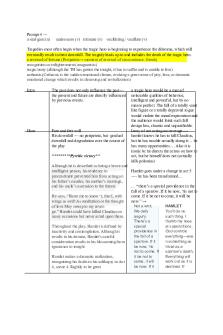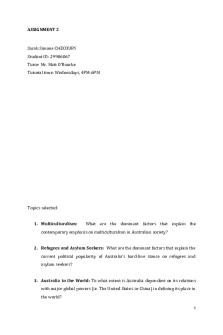Modernity essay 2 Frankenstien PDF

| Title | Modernity essay 2 Frankenstien |
|---|---|
| Course | Newfoundland Literature |
| Institution | Memorial University of Newfoundland |
| Pages | 4 |
| File Size | 134.4 KB |
| File Type | |
| Total Downloads | 74 |
| Total Views | 118 |
Summary
English Literature Essay...
Description
Shaping Modernity Essay Barbara Johnson observed that Frankenstein is “the story of the experience of writing Frankenstein.” Explain Mary Shelly’s Frankenstein was influenced by her own life story, the exposure she got throughout her life and her traits and characteristics. These are reflected in the story of Frankenstein, from her autobiographical details of motherhood, to the passivity of women, pressure from others on her work. Mary is known as the daughter of two important figures of the 19th century, William Godwin and Mary Wollenstonecraft, and the wife of Percy Shelly. She had been encouraged to prove herself through her writing and imagination since her early days. “In our family Mary’s step sister Claire Clairemont once wryly remarked,” if you cannot write an epic poem or novel, that by its originality knocks all other novels in the head, you are a despicable creature, not worth acknowledging” (Poovey, 1980 p. 332). She was also under pressure from her husband “But the narrative that Mary Shelley wrote between that “eventful” summer and the following April was less a wholehearted celebration of the imaginative enterprise she had undertaken in order to prove her worth to Percy than a troubled, veiled exploration of the price she had already begun to fear such egotistical self-assertion might exact.” (Mary Poovey, The Lady and the Monster). Perhaps to gain approval and praise, she dared to produce a piece that would defy all conventional norms of morality and practice adolescent audacity being a female in her youth in the early 19th century, it was also the ghost-story-writing competition which made her produce such a gothic novel, apart from the many other reasons. Mary visited Switzerland while writing the text of Frankenstein. She eloquently described the vivid details of the storms over icy mountains. The focus on nature’s sublimity such as storms in Belrive, Switzerland or the Lake Geneva “darkness and storm increased every minute, and the thunder burst with a terrific crash over my head. It was echoed from Salêve, the Juras, and the Alps of Savoy; vivid flashes of lightning dazzled my eyes, illuminating the lake, making it appear like a vast sheet of fire…” (Frankenstein chapter 6, volume 1). The pursuit of sublimity does not only exist in terms of nature but the very existence of the monster itself and its birth in the laboratory. The inclusion of different texts, such as stories, poetry and characters, of all whom Mary had encountered through her readings and the people she knew such as Coleridge, Byron and her husband Percy Shelley, who were Romantic writers, and because her interactions with their work, it is no surprise that she writes a Romantic novel. The feelings of compassion, love, hatred, rejection and the overall air of remorse and depression which is the tone of the novel, the monsters’ mixed feelings towards the human race, the representation of sublime experience, the rebellion against his creator and the research for answers are all elements which make up a Romantic novel. Adding quotes or parables from Coleridge’s “The Rime of the Ancient Mariner” which Walton writes to his sister or the mention of Paradise Lost several times through the novel, the novel begins with a quote from the Prometheus were pieces of work which Mary had close acquaintance with.
The passivity of women in her novel is another remarkable reflection of her own mirror image. The women are shown as submissive and compliant to the situation they are put in. For instance when Justine is wrongly accused of murder of William, although she defends herself in a speech, but she accepts her fate and agrees to her execution. Similarly Elizabeth, Victor Frankenstein’s cousin and later wife, passively awaits Victor’s arrival and does not take part in acquiring knowledge and travelling, instead he becomes a traditional housekeeper, which is evident from her letters she and Victor exchange. “She was docile and good tempered, yet gay and playful as a summer insect. Although she was lively and animated, her feelings were strong and deep, and her disposition uncommonly affectionate. No one could better enjoy liberty, yet no one could submit with more grace than she did to constraint and caprice.” (Frankenstein chapter 1, volume) For Shelley, writing a piece that would fulfil her desire of self-expression, was a question of desire to be answered being indirect and self-effacing in an acceptable manner. “Desire for Shelley a drive that can and must be regulated – specifically by the give-and-take of domestic relationships. If it is aroused and not controlled, it will project itself in the natural world, becoming voracious in its search for objects to conquer and consume… major dynamic of Frankenstein’s plot” (Poovey, p.334). Thus, the conflicting modes of self-expression of both Mary and Victor is another aspect which they share. However, the women have an important place in the novel. They somewhat stabilizes the family life and social relationships. “…absent mother being replaced by the closest female equivalent; ideally Elizabeth would link Frankenstein’s maturity to his youth, just as Mrs. Saville would anchor the mariner Walton.” (Poovey p.335). Also, the paradox of disapproval of self-assertion and profound egotism in Mary is striking. The egotism exists in the form of the tone, tenses, such as writing in first-person. “The first person, symbolic presentation of the monster within a literalized landscape thus qualifies Shelley’s condemnation of self-assertion…” (Poovey p.338). But tragically what the desire of Frankenstein is, creating a being using his pursuit of ‘dangerous knowledge’, leads to destruction of domestic tranquility. It completely hinders his communication with his family, shatters his mental peace of mind and shuns him of all happiness for the rest of his life. In Mary Shelley’s personal life, domestic tranquility was destroyed due to multiple deaths in her family. But horrors of motherhood had the biggest impact on her life because she was just sixteen when she lost her infant William, whose name she used as the first victim of the monster in her novel. Another parallel which can be drawn from Frankenstein with Mary’s life is that both Victor and Mary are somewhat introverted. Victor is occupied in his work and gives little time to his family, and after the creation of the monster his antisocial behavior and absorption in his practical use of ‘dangerous knowledge’ increased. Meanwhile Mary seems to be a passive spectator of the natural world to which she describes in the novel. In the introduction, it says “Mary chose well the wild and untamed mid-European setting for her tale of discovery and uncertainty, and it was one of those strokes of creative fortune that the Romantic taste for the picturesque, the sublime, the striking, and the haunting led not only to recognizable actual settings but also to projected imaginations in remote, exotic, unexplored northern climes still elusive to all but the most daring explorers” hence she has carefully chosen the backdrop details in her novel.
Considering what Barbara Johnson wrote in “my monster/my self” that the connection between mary’s life and that of victor, is of ambivalence toward motherhood, and perhaps Mary also felt rejection of her new born infant, because she was carrying the child of the man who was married to someone else and so analogically “Mary Shelley describes a parent who flees in disgust from the repulsive being to whom he has just given birth” (Johnson p.21) and later she says “… I bid my hideous progeny go forth and prosper.” The reader begins to suspect that there may perhaps be meaningful parallels between Victor’s creation of his monster and Mary’s creation of her book” (Johnson p.22) Taking into account the points mentioned above, backed by quotes from Mary Poovey and Barbara Johnson’s essays and the novel Frankenstein itself, it seems plausible that Mary Shelley used her own experiences and the situations she encountered as plots of the piece of work she created.
References
Poovey, Mary. “My Hideous Progeny: Mary Shelley and the Feminization of Romanticism.” PMLA, vol. 95, no. 3, 1980, pp. 332–347. www.jstor.org/stable/461877. Poovey, Mary. “My Hideous Progeny: The lady and the monster” Shelley, Mary. “Frankenstein” 1818
Johnson, Barbara. "My Monster/My Self." 1989....
Similar Free PDFs

Modernity essay 2 Frankenstien
- 4 Pages

Modernity
- 4 Pages

Travel Technology modernity
- 33 Pages

Essay 2
- 5 Pages

Essay 2
- 2 Pages

Tort Essay - Grade: 2:2
- 4 Pages

Essay 2 - Grade: 2:1
- 14 Pages

EC2 Essay PT 2
- 3 Pages

Essay 2 outline
- 4 Pages

Asessment 2 - Essay
- 6 Pages

ATS2269 Essay 2
- 10 Pages

Formal Essay Stage 2
- 7 Pages
Popular Institutions
- Tinajero National High School - Annex
- Politeknik Caltex Riau
- Yokohama City University
- SGT University
- University of Al-Qadisiyah
- Divine Word College of Vigan
- Techniek College Rotterdam
- Universidade de Santiago
- Universiti Teknologi MARA Cawangan Johor Kampus Pasir Gudang
- Poltekkes Kemenkes Yogyakarta
- Baguio City National High School
- Colegio san marcos
- preparatoria uno
- Centro de Bachillerato Tecnológico Industrial y de Servicios No. 107
- Dalian Maritime University
- Quang Trung Secondary School
- Colegio Tecnológico en Informática
- Corporación Regional de Educación Superior
- Grupo CEDVA
- Dar Al Uloom University
- Centro de Estudios Preuniversitarios de la Universidad Nacional de Ingeniería
- 上智大学
- Aakash International School, Nuna Majara
- San Felipe Neri Catholic School
- Kang Chiao International School - New Taipei City
- Misamis Occidental National High School
- Institución Educativa Escuela Normal Juan Ladrilleros
- Kolehiyo ng Pantukan
- Batanes State College
- Instituto Continental
- Sekolah Menengah Kejuruan Kesehatan Kaltara (Tarakan)
- Colegio de La Inmaculada Concepcion - Cebu



